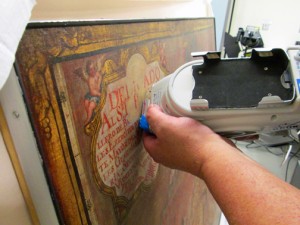Since joining the Palace of the Governors’ collections in 1977, an 18th-century map painted by Bernardo Miera y Pacheco has slowly but surely revealed its secrets. Thanks to the Museum of International Folk Art’s upcoming exhibition, The Red that Colored the World, we’re learning what types of red paint the master artist/cartographer/politician used.
We’re honored that our painting will join the exhibit. Before it does, though, Mark MacKenzie, director of the Museum of New Mexico Conservation Department, wanted to find out what the various reds contained—cochineal, vermillion, iron?
 In January, he took aim at small portions of the painting with a device that looked like it belonged on the Starship Enterprise. (More on that resemblance in a minute.) The handheld Bruker XRF spectrometer—a cream-of-the-crop instrument—was recently upgraded for conservation with funding from Don Pierce’s generous bequest to Department of Cultural Affairs entities. The device enables researchers to study the elemental composition of things like paint on a canvas without disturbing even a speck of that paint.
In January, he took aim at small portions of the painting with a device that looked like it belonged on the Starship Enterprise. (More on that resemblance in a minute.) The handheld Bruker XRF spectrometer—a cream-of-the-crop instrument—was recently upgraded for conservation with funding from Don Pierce’s generous bequest to Department of Cultural Affairs entities. The device enables researchers to study the elemental composition of things like paint on a canvas without disturbing even a speck of that paint.
MacKenzie was most interested in the red on the map’s compass rose and the hint of it on the arm of a cherub. Pointing the gun-like tool at the compass rose, he held it still for 30 seconds as the X-rays did their work, then watched as a computer screen revealed EKG-like spikes denoting what elements it had found. “Ooh, big iron spike,” he said.
That finding involved a field of vermillion red, which begins with the mineral cinnabar and normally appears on canvas as a scarlet red. On the painting, though, the red has a different cast. MacKenzie traveled in time to Miera y Pacheco’s palette, saying, “The painter wanted a slightly different hue. He started with vermillion, then added a little bit of iron red for his vision of the compass rose.”
On the cherub, he anticipated the glaze-like red to report back as cochineal, which comes from a cactus beetle rather than a mineral.
“Vermillion is not as opaque as lead red or iron red, but it’s not as translucent as cochineal,” he said. “When you see flesh in a painting, often you have a glazing layer on top, and that’s likely a cochineal-rich paint.”
 As for that Star Trek device? It was invented by a scientist intent on recreating the tricorders used aboard the fictional Starship. Rather than coming up with a device that can only diagnose health problems, though, he produced something more along the lines of a directed-energy weapon.
As for that Star Trek device? It was invented by a scientist intent on recreating the tricorders used aboard the fictional Starship. Rather than coming up with a device that can only diagnose health problems, though, he produced something more along the lines of a directed-energy weapon.
“He was challenged to build a tricorder, and he came up with a phaser,” MacKenzie said. “How Trekkie is that?”
